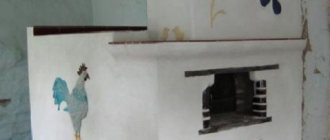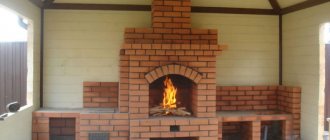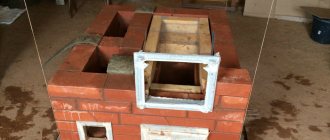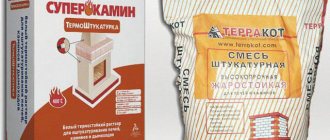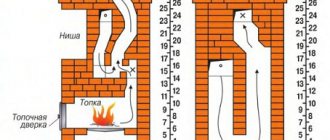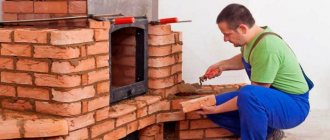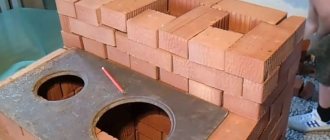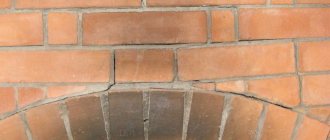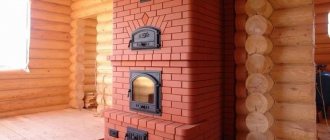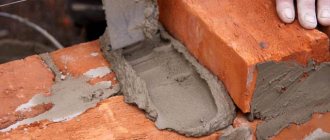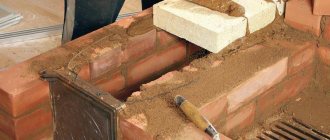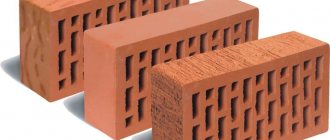- Refractory
- Visual inspection
Not every building material is suitable for the construction of an effective heating device and a safe gas exhaust channel. Therefore, we propose to consider bricks for laying a stove: which ones are better, what shape, color or size they may have, how to choose and distinguish high-quality from bad, what kind of manufacturers produce them. After reading this information, you will know what and in what quantity to buy for arranging the foundation, the lining itself, and how not to overpay.
People continue to prefer high heat storage, practicality that allows you to build different shapes, and the special comfort of a traditional appearance. Long service life and environmental friendliness are a classic solution for years to come.
Composition, production and types of oven bricks
Based on the conditions arising from the combustion of solid fuel, stove bricks must meet three basic requirements:
- Heat resistance of at least 1000 °C without loss of strength during prolonged exposure.
- Low thermal conductivity provides protection to surrounding building structures.
- Thermal resistance The product must withstand a significant number of heating and cooling cycles.
Kiln refractory bricks are an excellent energy accumulator, in other words, they heat up quickly enough and gradually release heat into the environment. Refractory bricks are manufactured in specialized factories using the technologies provided for by GOST 390-96. The composition of the raw materials used for the production of stove bricks as the main component includes refractory clay of special grades up to 70%. The introduction of certain types of charge into the molding mass makes it possible to obtain blocks with different properties; additives can include:
- graphite;
- coke in powder form;
- large fractions of quartz powder.
The technology for producing fire-resistant bricks using the semi-dry pressing method involves performing a number of operations in the following sequence:
1. Preparation of raw materials: grinding and kneading the clay, introducing the mixture, mixing until the composition is homogeneous. During this process, up to 8-10% water is added to the composition to achieve the required humidity.
2. The finished mass is loaded into a hopper, from which it enters a dosing carriage moving back and forth.
3. The molded brick is fed to the lower punch of the mold, which is lowered along with the workpiece.
4. The top of the press lowers and applies enough pressure to the brick to compact it.
5. Upon completion of the process, the lower punch pushes the block out of the mold onto the platform. At this moment, the carriage begins to move from under the hopper with the next portion of raw materials and moves the workpiece onto the conveyor belt.
6. The pressing process is repeated, and the raw brick is sent as the batch is formed for firing in a tunnel-type kiln at a temperature of about 1000 ° C.
This technology eliminates the operation of pre-drying the product and reduces its production time. This method of producing fire-resistant bricks is much cheaper than the plastic molding method, when a continuous beam is made from the prepared mass with a moisture content of 17-30%. The workpiece is cut into separate blocks by a special machine, which are fed for preliminary drying followed by firing.
The building materials market offers a wide range of fire-resistant oven bricks of the following types:
Fireclay stove brick
Semi-acid refractory brick
Dynasty refractory brick
Mullite fire brick
Corundum refractory brick
| Type of fire brick | Brands of refractory bricks |
| Chamotte | SHAK; ША-I; ShB-I; ShV-I(II); SHUS. |
| Semi-sour | PB-I; PB –II; PV-I; PV-II. |
| Dinas | DN |
| Fireclay and semi-acid lightweight | ShLA-1.3; ShKL-1,3; ShL-1.3; ShL-1.0; ShL-0.9; SHTL-0.6; ShL 1-6.4; ShL-0.4. |
| Lightweight mullite-siliceous | MCRL-0.8 and MCRL-0.7 |
| Mullite lightweight | MLL-1,3 |
| Lightweight corundum | KL-1,1 |
| Dinas lightweight | DP1-1,2 |
| Mullitocorundum | ISS-72 |
| Mullite | MLS-62 |
Technical characteristics of kiln refractory bricks depend on the type and brand; for convenience, they are summarized in the table:
| Index | Normal value for this brand of brick | ||||||
| SHAK | SHA | ShB | SHV | SHUS | PB | PV | |
| Fire resistance, °C | 1730 | 1690 | 1650 | 1630 | 1580 | 1670 | 1580 |
| Porosity of products, % | 23 | 24 | 24 | — | 30 | 24 | — |
| Tensile strength, N/mm2 | 23 | 20 | — | 22 | 12 | 20 | 15 |
| Additive content | |||||||
| Al2 O2 | 33 | 30 | 28 | 28 | 28 | — | — |
| Al2 O3 | — | — | — | — | — | 14 — 28 | 14 — 28 |
| SiO2 | — | — | — | — | — | 65 — 85 | 65 — 85 |
Criteria and requirements
In order for the heating structure to last for a long time, it is necessary to make masonry from high-quality raw materials suitable for specific conditions. The material is selected individually for each home or room, taking into account the wishes of the owner, based on the main characteristics of brick products. The criteria for which brick is best to build a stove from may be different, but the requirements for this building material are the same.
Marking
Blocks for assembling furnaces are separately marked with the letter M, after which they put a digital designation of the weight load to withstand. The numerical parameter is calculated for each square centimeter of the product and can vary from 150 to 250 kg.
It is better to ignore other letter designations - the letters U (thickened) or P (hollow, hollow) are completely unsuitable for the construction of stoves.
Fireclay blocks are designated by the letter Ш, after which the presence of the signs A or B is a direct indicator of their purpose for laying furnaces. When a number is written instead of the second letter, it means that the manufacturer deviated from the standard procedure during the manufacture of bricks. But this release method must be carried out in accordance with approved technical specifications.
Marking
Heat-resistant bricks for stoves, which are best suited for heating structures, are most often not marked in any way.
What kind of brick is needed for laying a stove? When choosing raw materials, you should pay attention to the presence of a label on the frost resistance of the product, which is also important when building a structure. Optimal indicators are any in the range from 75 to 100
Size
There are many options for bricks, among which there are standard sizes of red brick for laying a stove - 25*12*6.5 cm. This option is optimal for stove equipment and is very convenient to use.
There are wedge-shaped blocks, one half of which is 2-3 cm narrower than the other. This option is used in rotating places, when laying out the outer part of the crucible, if cooking or heating food using an oven is intended.
Dimensions
It is possible to use European products of a thickened or modular type, which have slightly different dimensions: 25 * 8.8 * 6.5 cm.
Form
Brick blocks may vary slightly in shape. The best option is a standardized rectangular look, but for a more complex look, you can use one of three options: wedge-shaped, rib or end blocks. The wedge shape involves smoothing one corner, which helps to make corner areas as beautiful as possible or lay out interesting decor. For the end and ribs, the blocks differ mainly in thickness.
Form options
Most often, when forming an arched vault, wedge-shaped bricks are used, in which one side is narrowed, which helps to make a neat turn.
Color
The color of a brick is a direct indicator of the quality of production. Uneven color or stains indicate a defective product.
Also, the color scheme helps to determine the intended purpose of the manufactured products: which ones are used for the construction of buildings, and which bricks are most often used for stoves. Red refractory blocks are used for laying stoves, as they are characterized by resistance to temperature changes and thermal pressure without compromising the integrity of the structure.
Color spectrum
In the places where the firebox and ash pit are formed, yellow bricks are used, since in these places there is no direct exposure to fire and heat. Otherwise, such blocks are called fireclay.
A white fireclay block meets all the characteristics perfectly as the main material for stove masonry, but is noticeably more expensive than its red counterpart. If you have general parameters, it doesn’t always make sense to overpay for a shade.
A more detailed analysis of brick products for building stoves is shown in the following video review:
Firebox lining
Cladding the fireplace insert with brick is one of the most popular types of finishing. A brick wall, having picked up heat from the firebox, will heat the room for a long time. To do the job correctly, adhere to the following rules:
- For finishing, use ceramic or facing bricks;
- Leave a gap of 5 cm between the masonry and the firebox for air circulation;
- To make perfectly even seams, use glazing beads;
- Remove excess solution immediately;
- After completing the work, coat the bricks with heat-resistant varnish.
Which brick is suitable for the stove?
The stoves are laid from solid bricks, without voids inside and single ones, of single height, corresponding to the module of this type of brick. Different types have different modules and characteristics. It is impossible to use bricks from different modules for one furnace, since in this case it is impossible to properly lay the seams and the structure will not be durable. As a last resort, a firebox is laid from bricks of another module, since it already needs to be built as a block built into the structure of the furnace as a result of thermal deformations.
Which brick should not be used for the stove?
Silicate, unfired raw materials and those cast using slip casting are absolutely unsuitable for the construction of a stove. Raw material is hygroscopic and will disintegrate due to oven breath. The first conducts heat very well and is not heat-resistant. In the latter, the binder does not sinter, but dries out and crumbles during combustion due to constant thermal shocks.
Clay red kiln brick
For ceramic red bricks, the manufacturing option is very important for the construction of a furnace. There are two options: semi-dry pressing and plastic molding. In the latter case, before firing, the molding mass is passed through a profiled die, creating a layer of the required configuration in the section, and it is cut into pieces of the required size.
In the first version, the molding mass with a small amount of water is placed in a mold, pressed, squeezing out the water, and fired. Semi-dry molding makes it possible to make dimensions more accurately.
The kiln requires only plastic molded ceramic products. Since water not only gives elasticity to the mass, during firing it takes part in chemical processes in it. Simply put, the clay in pressed products is sintered dry, which causes a lot of pores to appear. This module does not withstand thermal loads well and also breathes, figuratively speaking, like a racing horse.
Fireproof brick
This module is manufactured by firing and pressing at elevated temperatures. In kiln construction, fireclay bricks and, very rarely, quartz bricks are more often used. The second has a low coefficient of thermal expansion, so masonry is made from it in areas of contact with load-bearing steel embedded elements - pallets, beams, etc. But, since it is absolutely contraindicated to install loaded metal in a furnace, and quartz brick is expensive and is afraid of substances that have an alkaline or acidic reaction, it is not advisable to use it.
Clinker brick
It is made from a special clay-based composition - clinker - and fired at high temperature. By and large, this is an ordinary specially burnt brick. It is heavy, dark in color, and often has dried tarnish on the spoons.
The heat resistance is about 1200 degrees, it has high thermal conductivity and is quite durable. As a result of the almost complete absence of pores, it is quite frost-resistant. It is not afraid of most chemicals and matches perfectly with ceramic red brick. It is not often used in the construction of furnaces, as it is expensive, and in terms of heat resistance it is worse than fireclay.
Let's sum it up
For the firebox, an extremely heat-resistant option is more suitable; it is better to use a less heat-conducting one on the pipe, and in places of contact with a humid environment, the foundation and the upper part of the pipe, it is better to use a brick made of a material of appropriate resistance. The ash pit, firebox and chimneys are fireclay. For a chimney, the brick must be frost-resistant. And for finishing, ceramic or clinker facing is suitable.
Low-quality material for laying a stove is not suitable in principle. Therefore, one cannot count on a low price for the construction of this heating engineering structure. By saving on quality, it is possible to obtain only a fragile and short-lived structure.
Technical parameters of bricks
Brick size and shape
One of the unchanging rules for constructing stoves is the accuracy of the design. Most projects are designed for specific brick sizes. Therefore, which brick is best to build a stove from is a very important question.
Brickwork plans usually indicate not only the number of bricks, but also their dimensions. It is generally accepted that the standard dimensions of bricks correspond to the dimensions of a single type - length 250 mm, width - 120 mm and height 65 mm. This is considered the “gold standard”. However, it is worth noting that these are the dimensions established by the Soviet standard. Today, in addition to this traditional size, there are other sizes used for laying stoves:
- “Euro standard” - with the same length and height as the normal standard, its width is 85 mm (it is often designated 0.7 NF);
- Thickened brick (KU) - differs from the usual format in height, it is 88 mm (designation 1.4 NF);
- Single modular brick (KM) - length is 288 mm, width 138 mm, height 65 mm (designation 1.3 NF);
- Thickened brick with horizontal voids (KUG) has dimensions of a thickened brick of 250x120x88 mm (indicated by 1.4 NF).
There is another specific brick for laying stoves - a stove module, its dimensions are 230mm x 125mm x 65mm. Despite the fact that this standard is considered outdated, many successful stove designs have designs designed specifically for this size. The popularity of this kiln standard is such that many manufacturers of refractory bricks for individual kilns still produce bricks with dimensions specifically for the kiln module - 230x114x40 or 230x114x65 mm.
For the construction of firebox vaults and cladding arches, there is also a specific type of brick - wedge-shaped or arched. Its peculiarity is that the dimensions indicate both the wide side and the narrowed side, for example, 230x114x65/45 mm.
Ceramic bricks for stoves used for decoration can have different shapes. For example, have rounded corners, convex or concave sides, or have a glossy surface. The use of this type of material must be indicated in the ordinary furnace laying diagram.
Brick strength
The second point that you need to pay attention to when choosing bricks for laying stoves is brand strength. This characteristic shows how much load a brick can withstand without showing signs of deformation. The marking is usually indicated by the letter “M” and a number corresponding to the maximum load expressed in kilograms / square centimeter
Thus, the M150 marking is allowed for the construction of most stove designs. M 200 is suitable for the construction of a furnace for heating two floors. But higher grades, for example M-300 or M-500, are usually not used for the construction of stoves. The fact is that special chemical additives are used to mold a material of such density, so when heated, such a material partially loses its properties, which negatively affects the condition of the structure.
Frost resistance, thermal conductivity and hygroscopicity
Frost resistance of brick is especially important for the construction of stoves in houses where permanent residence is not planned in cold weather. It is usually designated by the letter F, next to which is indicated the minimum number of freeze-thaw cycles without loss of strength and the beginning of the process of mechanical destruction
This indicator is important for such structural elements as the base and head of the chimney pipe.
When choosing bricks for masonry, you should also pay attention to such an indicator as thermal conductivity - the ability of the material to retain heat
This is especially important for laying the walls of the firebox and chimney. For these purposes, material is taken with indicators not lower than 0.61 W/m×°C
For these purposes, material with indicators not lower than 0.61 W/m×°C is taken.
But as for hygroscopicity, you should choose the material with the lowest indicator. The lower the coefficient, the less the brick is able to absorb moisture. For the base and chimney, this is a very important indicator of the quality of the brick, since these are the parts of the structure that are most susceptible to moisture.
Recommendations for the selection and use of oven bricks
One of the disadvantages of fireclay bricks is that it is capable of absorbing moisture and then releasing it for a long time. Therefore, it is not recommended to store it outside. To lay out the main parts of the stove structure, you need to choose only red brick, and not burnt or unburned, since in this case its quality properties are lost. The brick must have an even shape with sharp edges and dimensions stated according to GOST.
The surface of the fireclay should be matte, without any film, which may indicate that the adobe may collapse due to possible temperature changes.
When you hit the surface of a brick block with a hammer, a clear, ringing sound should be produced. A dull sound indicates the presence of voids, as well as poor hardening and drying. There should be no traces left at the impact site.
When you split fireclay in half, you can judge its quality: the structure should be dense and homogeneous. It should not contain any foreign inclusions, including small pieces of clay - this indicates a violation of technology in the manufacture of brick material.
To build a furnace, it is enough to use the M250 brand of fireclay; the denser structure will take a very long time to warm up.
When choosing a material, you should pay attention not only to the size of the red brick for the stove, but also to the grade of its frost resistance, since it indicates the ability of moisture absorption and moisture separation, which is especially important when installing a chimney. To build a stove foundation, it is recommended to choose a brick with the lowest hygroscopicity, i.e. water absorption
water absorption
To build a stove foundation, it is recommended to choose a brick with the lowest hygroscopicity, i.e. water absorption.
Hyper-pressed adobe can be used when laying outdoor barbecue stoves, but it is not recommended for use in home stoves, since the limestone included in its composition is unstable to high temperatures and begins to collapse under the influence of the carbon dioxide released.
Brick for the stove
Red brick with a density of M200 cannot be used for laying the combustion chamber and chimney, as well as the street part of the pipe, since it can collapse within one to two years.
You can use old fireclay left over after the dismantling of buildings and structures, provided that its structure is not destroyed and the surface is intact. In this case, the old brickwork used had to be clay or cement. If the old masonry was on a limestone base, such adobe can only be used as a base for a fireplace or pipe heads. Old fireclay used when laying out stoves can also be used, provided that its surface is well cleaned of soot, otherwise, with new laying, black spots will appear on the outer surface of the pipes and the front part of the stove elements.
What is best to take for finishing
If the stove fulfills the designer’s intention and is part of the composition, then it is better to use plastic molded face stone for its finishing. It is almost always second grade; this is exactly what is needed for the shell of the structure.
When building a new one, the facing brick is placed outside:
- In this case, the finishing happens by itself, and you can kill several birds with one stone - the stove looks beautiful, begins to breathe freely, and turns out to be quite durable, because the seams are tied as expected;
- If you plan to veneer an old stove, then you don’t even have to think about bandaging the seams because the old ones are already dry. But the so-called thermal kicks will sooner or later do their dirty work and the lining will begin to fall. Previously, in such a situation, they acted as follows - first, the stove was lined with unglazed tiles containing lime mortar, and the brick itself was laid on top using the same mortar. The tile acted as a kind of damper. Now everything is much simpler, and it costs less: masonry mortar for cladding is mixed with aluminous cement;
- It also happens that the fireplace, according to the design decision, should look organically with the interior. In this case, there may be three options: hand-molded Yekaterinoslav brick, narrow decorative brick, clinker facing tiles. The latter type will not be cheap, but in terms of quality it is the most suitable: the clinker slab is durable, adheres well to the mortar, and is available in a wide variety of textures and colors. In addition, the stove will breathe - after all, the clinker has a small number of pores, and the tiles are too thin;
- Narrow brick is suitable for constructing fireplaces. But if you use it to finish the stove, it will not breathe. You need to buy it carefully: manufacturers often use polymer additives. According to the quality certificate issued for narrow bricks, its heat resistance should not be less than one hundred and forty degrees.
Suitable brick for masonry
Foundation
There is no clear answer to the question “Which brick is better to use to build a brick oven?” Each part of the oven requires a specific type.
The base of the stove is one of the most important parts. After all, it must withstand the entire structure. In addition to strength, such a material must have moisture-repellent and frost-resistant characteristics, because it is located near the ground. First-grade ceramic bricks have these qualities. It is very durable and can withstand even a massive structure. Sometimes clinker bricks are used to lay the foundation. It is also durable and frost-resistant.
Use ceramic bricks for the foundation
Firebox
The most suitable brick for firing a furnace is fireclay. It contains particles of fireclay, which have fire-resistant properties. The inner walls of the firebox are lined with this material, and simple ceramic is used for the outer ones.
You should not lay out the base of the firebox with ordinary brick, since the temperature in this compartment sometimes exceeds a thousand degrees, and in this case such material will become deformed and will not last long.
For the firebox - fireclay bricks
Smoke channels
Hot air from the firebox passes through the smoke ducts to the chimney. This means that the temperatures here are also high. This part of the furnace is also lined with fireclay refractory bricks.
Chimney
This part of the furnace device is affected by precipitation and wind, and hot air comes from the bottom of the firebox. The brick for the pipe must be heat-resistant and frost-resistant, because it can withstand temperature fluctuations from minus forty to three hundred degrees. For laying a stove in this area, you should choose ceramic bricks with the highest frost resistance.
Frost-resistant ceramic bricks are suitable for the chimney
There is another option: lay out a two-layer pipe. The first layer is made of clinker, and the second is made of hollow ceramic, which is strictly prohibited from being used in other parts of the furnace.
Facing
External masonry can be made using façade or facing material. The requirements for it are not as strict as for the others, since it is exposed to significantly low temperatures.
Clinker brick is suitable for cladding and masonry
Its only role is to maintain temperature and release it into the room. Construction ceramic, cladding or clinker options are suitable for this purpose.
Brick for a stove in a bathhouse or sauna
The laying of stoves in these rooms has some differences:
- For the firebox they do not use fireclay - this brick is needed for laying the stove in the house. Instead, you should take a ceramic fireproof one. Fireclay can withstand humidity of no more than 60 percent, and for ceramics this figure is higher;
- clinker building material will provide greater heat transfer, which is much more appropriate in a bathhouse;
- during the work you need to use only first-class bricks. It is unacceptable to install a stove or any of its parts from second-rate materials.
Features of clinker
Brick made using clinker technology from highly melting grades of clay has great strength (more than M300) and frost resistance (more than F 100).
The specific features of clinker are indispensable when laying the base layer of the foundation and the internal chimney channel reaching the cap, provided that the cladding is decorated with a different material.
Making the main part of the stove out of clinker is an expensive and unjustified pleasure, especially since the structure will be massive and heavy.
If the owner plans to make a compact stove in a bathhouse, clinker brick will be an ideal material that will allow heating the space no worse than a thick-walled cast iron “potbelly stove.”
Methods for determining the quality of kiln bricks
Checking the compliance of this type of building materials with the requirements of regulatory documents is carried out using methods that are approved by the GOST series. Each of them is designed to determine individual characteristics of refractory bricks:
- GOST 5402.1-2000. Method for determining residual deformations after heating.
- GOST 4069-69. Method for monitoring the fire resistance of products.
- GOST 151136-78. Methods for measuring damage to corners and edges of ceramic blocks.
Brick studies are carried out in laboratories using special equipment. At home, it is impossible to check the quality of refractory bricks using the methods described in the standards. The buyer has to rely on the certificates and qualifications of the craftsman, who it is advisable to involve in deciding on the choice of material for the construction of the furnace.
Experienced stove makers are able in many cases to determine the quality of refractory bricks based on certain characteristics. Furnaces are constructed only from solid ceramic bricks with grades from M150 to M250. In this case, the certificate must contain an entry stating that the specified product is intended for this type of work.
To determine the properties of bricks, the following methods are used:
Vibration and sound. Apply a weak blow with a hammer to the large edge of the brick that is held suspended. The tool should bounce off the surface with a ringing sound. This indicates the absence of internal cracks.
Inspection of appearance. The brick must have the correct shape with a maximum deviation from the standard size within 2 mm in one direction or the other.
Internal structure. It is assessed by the condition of the chip, and the color of the section should be uniform over the entire area. The presence of spots indicates the presence of areas of stress in the brick mass, which can cause its destruction when heated. There should be no chamotte chipping from the internal structure of the material.
Using the above methods for assessing the quality of refractory ceramic bricks for construction in a kiln will allow you to select the material necessary for this. The use of building bricks that meet the requirements of GOST will provide the heating unit with the appropriate level of strength and reliability.
What properties should a brick used for laying a stove have?
Kiln bricks must meet the following technical requirements:
- Resistant to high temperatures and open flames.
- The ability to accumulate heat and retain it for a long time.
- Sufficient mechanical strength.
- Resistant to significant temperature fluctuations.
Solid fuel stoves are built from ceramic bricks that meet the requirements of GOST 390-96. This standard came into force on July 1, 1997 and establishes the technical conditions that these products must comply with in shape and size. The regulatory document also defines the requirements for the use of products depending on the maximum ambient temperature.
Ceramic bricks intended for the construction of thermal units are subject to more stringent requirements than other building materials. In the firebox of furnaces, the flame temperature can exceed 1000 °C; therefore, its walls are subjected to significant thermal loads. The thermophysical parameters of the material used must be higher than the specified value.
During the operation of the furnaces, they are regularly cooled in some cases to negative temperatures. In this case, the brick is exposed to a significant temperature difference in the external environment, which leads to thermal expansion followed by compression. The product must have a sufficient strength margin to successfully withstand this phenomenon and avoid deformation and destruction. The brick used for laying stoves must have sufficiently high thermal conductivity and the ability to accumulate heat. The first property is necessary for quickly heating the room and transferring the energy of burned fuel to the external environment. The second quality allows you to maintain this process after the combustion in the furnace stops for a long time. This allows you to maintain a comfortable thermal regime for a long time.
How to choose quality brick?
When purchasing, we make sure to selectively inspect the entire batch of blocks and perform a visual inspection of the material
Experienced builders recommend paying special attention to several points in the table
| Color | It must be painted evenly over all surfaces and on chipped or cut areas. If you see cleared areas, the material did not withstand a certain area under the influence of high temperature during firing. Dark spots at the fracture sites indicate a violation of the temperature regime; such bricks were subjected to high temperatures. |
| Interspersed. | If small inclusions of a different color are found at the fracture sites, such blocks contain an impurity that is not always useful. If mica-coated areas are found on the surfaces, it is not recommended to buy such material; it is 100% defective. |
| Block shape. | It must be geometrically correct, with right angles. There are significant chips or other defects on the edges - this is a mismatch or defect. |
| Dimensions. | If during measurement a 2 mm deviation from the block dimensions is detected, such products were made in violation of technology. |
| Sound. | If a brick “sings” with a clear sound when struck and there is no significant dent on the surface, you can safely pay for such a product. |
Important! Before building a stove, we recommend purchasing the entire set of materials from one manufacturer. The ideal option is bricks from the same batch
In this case, they will 100% not differ in color.
Where can I buy?
This question is important for many home craftsmen. Definitely large specialized construction stores. It is better if the company is an official dealer of the manufacturer.
The most important thing is where to buy stove blocks. It is much more important to check their quality and all documentation from the sellers. Sometimes construction markets charge high prices for products from well-known brands. Use the data provided in this article and carefully check the quality and measure the dimensions of heat-resistant bricks. At the slightest deviation, think - maybe go to another store and look for quality material?
Barbecue bricks - which one to use when building ovens
To create barbecue ovens, ordinary, facing and refractory bricks are used.
The need to purchase facing material arises if special stove bricks are not used in construction or to maintain an attractive appearance while saving money by using old bricks.
The marking of optimal solid kiln bricks is M-250, M-200 or, as a last resort, M-150.
Main types of bricks - deciding on the choice
To understand what materials to use for a barbecue oven made of brick, you first need to understand the characteristics and main parameters by which they are distinguished.
By application:
- ordinary construction;
- refractory;
- clinker - facing.
By composition:
- sand-lime brick;
- fireclay;
- ceramic;
- hyper-pressed.
According to the internal structure:
- hollow;
- full-bodied.
It can be difficult to distinguish brick barbecue materials by appearance, so you need to pay attention to the markings. It encrypts the following information:
- Strength grade - the higher the indicator, the stronger the brick, the better it is able to withstand loads without mechanical damage. It happens in the range from M-25 to M-500;
- Internal design - no designation for solid, “P” for hollow, “U” for thick;
- Weight, size - to calculate the future load on the foundation;
- Manufacturer's abbreviation or name;
- Frost resistance - from F-15 to F-75, indicates the ability to withstand a certain amount of freezing and thawing without loss of strength;
- Water absorption (%) - a minimum indicator is required for the construction of the foundation, it is not particularly important for the remaining parts of the barbecue stove design;
- Material of manufacture.
Ceramic tile
Glazed metal tiles are a way to decorate your fireplace without breaking the bank. You can choose tiles that imitate brick, granite, or marble finishing. It looks good in combination with decorative brick or plaster.
Modern technologies make it possible to print photos on ceramic tiles. Decorative tiling of a brick fireplace is economical, but gives a good result. The pattern on the fireplace can be chosen to suit any interior.
Note! The surface of the tile does not resist temperature deformation well; it is not used for lining stoves. The facade of fireplaces heats up slightly, so tiles are suitable for cladding.
Choosing a kiln brick manufacturer
The market for this type of building materials is extremely saturated with products from domestic and foreign companies. In this segment, products produced by enterprises from Russia, Belarus and the Baltic republics are widely represented.
Vitebsk brick factory, workshop No. 1.
Ceramic bricks from this manufacturer meet the requirements for material for stoves according to the density grade. The frost resistance of the products is extremely low. Density grade 180 - 200. Brick can be used for lining stoves and chimney ducts; it is not suitable for other elements. We can say that this is one of the most common materials for constructing a stove today. It cannot be used for laying the firebox and the first chimney of the stove. It is required to line the firebox and the first chimney with refractory fireclay bricks.
With constant direct contact with fire, this brick is destroyed quite quickly. Since the product has low frost resistance, the use of this brick for laying the outer walls of a street chimney pipe is also excluded. The advantages of this material include the fact that it is one of the most budget options and, taking into account all the nuances, it is quite possible to use it for laying a stove. Has 2 working surfaces. In general, the quality of this brick can be described as satisfactory.
LODE.
LODE brand bricks are produced in the Baltic states. Ceramic brick has a high density grade - 500 and frost resistance. The product is used for lining the outer surfaces of the stove and chimney. Bricks of this brand have various shapes and are often used to create all kinds of decorative elements for the stove. According to its main purpose, it is a facing brick.
Borovichi brick factory.
Products of the Borovichi brick factory, located in the Novgorod region. Mass production of products began in 2011, experts assess their quality as good. Density grade of ceramic brick is M-250, frost resistance at F25. There are significant deviations of products from the sizes established by the standards, up to 10 - 12 mm in one batch. This must be taken into account when laying the stove and it is best to take a little more brick than needed. Further, everything depends on the professionalism of the stove maker and his ability to select the right products. The brick has rounded upper and lower edges and 3 working surfaces.
Fireproof or fireclay bricks made in Russia.
The quality of the products varies greatly, from obvious defects to quite decent products. Fireclay brick has an even cream color and high density, the shape is regular with right angles. As we found out earlier, this brick is necessary for lining the combustion chamber of classic stoves, hearths and fireplaces. But it is quite difficult to single out specific manufacturers here.
The answer to the question of which brick is best for a stove is usually decided by the customer in agreement with the foreman. It takes into account several factors, the main ones being compliance with standards and cost. The operational properties of the structure depend on the correct choice of fireproof bricks; saving at the expense of quality is expensive.
Tiles
A special three-dimensional ceramic form was invented for lining stoves many centuries ago. The tiles are installed simultaneously with the laying of the stove and are securely fastened with wire in the brick seams.
The multicolored relief patterns are amazing. Stoves and fireplaces decorated with tiles are considered high art.
